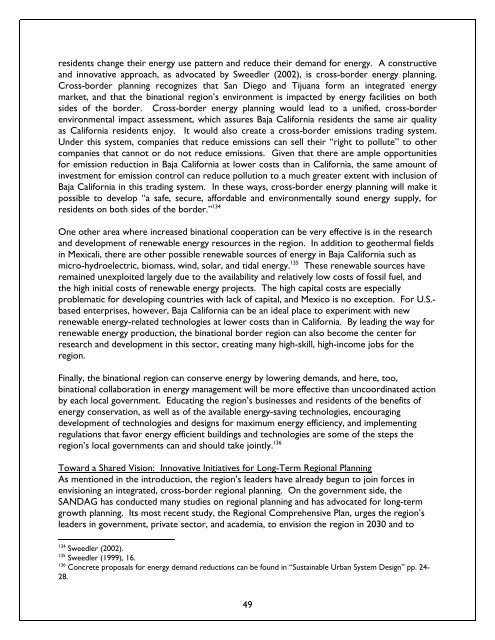Blurred Borders - International Community Foundation
Blurred Borders - International Community Foundation
Blurred Borders - International Community Foundation
Create successful ePaper yourself
Turn your PDF publications into a flip-book with our unique Google optimized e-Paper software.
esidents change their energy use pattern and reduce their demand for energy. A constructive<br />
and innovative approach, as advocated by Sweedler (2002), is cross-border energy planning.<br />
Cross-border planning recognizes that San Diego and Tijuana form an integrated energy<br />
market, and that the binational region’s environment is impacted by energy facilities on both<br />
sides of the border. Cross-border energy planning would lead to a unified, cross-border<br />
environmental impact assessment, which assures Baja California residents the same air quality<br />
as California residents enjoy. It would also create a cross-border emissions trading system.<br />
Under this system, companies that reduce emissions can sell their “right to pollute” to other<br />
companies that cannot or do not reduce emissions. Given that there are ample opportunities<br />
for emission reduction in Baja California at lower costs than in California, the same amount of<br />
investment for emission control can reduce pollution to a much greater extent with inclusion of<br />
Baja California in this trading system. In these ways, cross-border energy planning will make it<br />
possible to develop “a safe, secure, affordable and environmentally sound energy supply, for<br />
residents on both sides of the border.” 134<br />
One other area where increased binational cooperation can be very effective is in the research<br />
and development of renewable energy resources in the region. In addition to geothermal fields<br />
in Mexicali, there are other possible renewable sources of energy in Baja California such as<br />
micro-hydroelectric, biomass, wind, solar, and tidal energy. 135 These renewable sources have<br />
remained unexploited largely due to the availability and relatively low costs of fossil fuel, and<br />
the high initial costs of renewable energy projects. The high capital costs are especially<br />
problematic for developing countries with lack of capital, and Mexico is no exception. For U.S.based<br />
enterprises, however, Baja California can be an ideal place to experiment with new<br />
renewable energy-related technologies at lower costs than in California. By leading the way for<br />
renewable energy production, the binational border region can also become the center for<br />
research and development in this sector, creating many high-skill, high-income jobs for the<br />
region.<br />
Finally, the binational region can conserve energy by lowering demands, and here, too,<br />
binational collaboration in energy management will be more effective than uncoordinated action<br />
by each local government. Educating the region’s businesses and residents of the benefits of<br />
energy conservation, as well as of the available energy-saving technologies, encouraging<br />
development of technologies and designs for maximum energy efficiency, and implementing<br />
regulations that favor energy efficient buildings and technologies are some of the steps the<br />
region’s local governments can and should take jointly. 136<br />
Toward a Shared Vision: Innovative Initiatives for Long-Term Regional Planning<br />
As mentioned in the introduction, the region’s leaders have already begun to join forces in<br />
envisioning an integrated, cross-border regional planning. On the government side, the<br />
SANDAG has conducted many studies on regional planning and has advocated for long-term<br />
growth planning. Its most recent study, the Regional Comprehensive Plan, urges the region’s<br />
leaders in government, private sector, and academia, to envision the region in 2030 and to<br />
134<br />
Sweedler (2002).<br />
135<br />
Sweedler (1999), 16.<br />
136<br />
Concrete proposals for energy demand reductions can be found in “Sustainable Urban System Design” pp. 24-<br />
28.<br />
49















